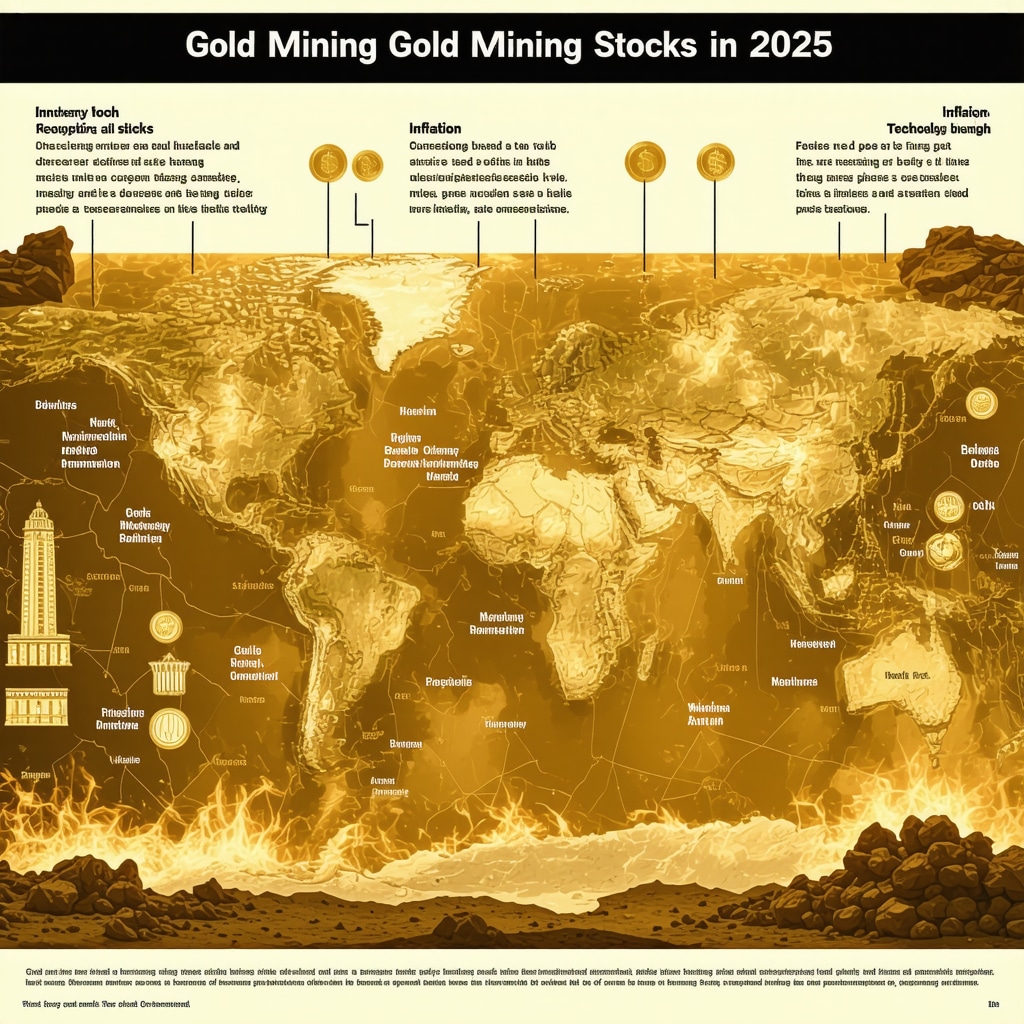Gold Rush 2.0: Why Mining Stocks Are the New Frontier for Beginners
If you think investing in gold means just buying shiny coins or bars, think again. The real treasure trove might just be lurking beneath the earth’s crust in the form of gold mining stocks. But before you dive headfirst into this glittering pool, you need to know how to evaluate these stocks without falling for fool’s gold. Welcome to the beginner’s guide for 2025, where we turn the complicated world of mining stocks into a walk in the park—or should I say, a stroll through the mine?
Digging Deeper: What Makes a Gold Mining Stock Sparkle?
Gold mining stocks aren’t your run-of-the-mill investment. Their value is influenced by a cocktail of factors like the price of gold, mining costs, geopolitical stability, and even environmental regulations. But how do you separate the nuggets from the dirt? Start by examining the company’s production costs — the lower the cost per ounce, the better the margin when gold prices rise. Next, peek into their reserves and exploration potential. A company with a promising pipeline of new deposits might just be your golden ticket.
Is It All Just About the Gold Price?
A common misconception is that gold mining stocks simply track the price of gold. But here’s the kicker: mining stocks often amplify gold’s price movements due to operational leverage. When gold prices soar, these stocks can skyrocket, but when prices fall, they tend to plunge faster. This volatility means you need to assess not just the current gold price but also the company’s financial health and management expertise. For a deep dive into gold price trends and what drives them, this analysis offers invaluable insight.
Following the Gold Trail: The Importance of Management and Environmental Practices
Behind every successful mining stock is a savvy management team that knows the lay of the land—literally and figuratively. Look out for transparency in reporting, a track record of meeting production targets, and a sensible approach to debt. Also, in today’s world, environmental, social, and governance (ESG) factors are no longer just buzzwords. Companies investing in sustainable mining practices tend to have better long-term prospects and less regulatory risk.
Ready to Stake Your Claim? Share Your Thoughts!
So, are you ready to add some sparkle to your portfolio with gold mining stocks? Or maybe you’ve already struck gold and have tips for fellow investors? Drop your thoughts in the comments below and join the conversation! For those who want to explore beyond stocks and understand broader market influences, this comprehensive guide on gold supply and demand is a must-read.
Remember, as the legendary investor Warren Buffett once said, “Risk comes from not knowing what you’re doing.” So, do your homework, stay curious, and may your gold mining ventures in 2025 glitter with success.
Source: According to the World Gold Council, gold mining companies with robust ESG practices tend to outperform their peers in the long run (World Gold Council – Gold Demand and Supply).
Unraveling the Nuances: How Macro Trends Influence Gold Mining Stocks
While many investors focus squarely on gold prices and company fundamentals, it’s crucial to appreciate the broader macroeconomic and geopolitical factors shaping gold mining stocks in 2025. Inflation rates, currency fluctuations, and global trade tensions can all directly or indirectly impact the profitability and valuation of mining companies. For example, a weakening US dollar typically supports higher gold prices, which can amplify gains for mining stocks. Conversely, rising interest rates may increase borrowing costs, squeezing margins. Staying attuned to these variables helps investors anticipate market movements with more precision.
Moreover, emerging trends such as technological advancements in mining operations and shifts towards green energy can redefine cost structures and operational efficiencies. Companies investing in automation and renewable energy sources may gain a competitive edge, improving their long-term viability and appeal to ESG-conscious investors.
How Can Investors Strategically Balance Risk and Reward in the Volatile Gold Mining Sector?
Given the inherent volatility amplified by operational leverage in mining stocks, a strategic approach to risk management is indispensable. Diversification across different mining companies, regions, and stages of development can mitigate company-specific risks. Additionally, blending mining stocks with other gold investment vehicles like ETFs or physical bullion can offer smoother returns and hedge against sector-specific shocks.
Active monitoring of quarterly production reports, cost trends, and management commentary allows investors to spot red flags early. It’s also prudent to consider the political stability of the jurisdictions where mines operate, as sudden regulatory changes or geopolitical unrest can dramatically impact output. This detailed forecast underscores the importance of these multifaceted factors in shaping investment outcomes.
Embracing Sustainable Mining: A Catalyst for Value Creation?
Environmental stewardship is no longer merely a compliance checkbox but a strategic driver for mining companies. Firms that proactively adopt sustainable mining practices not only minimize environmental liabilities but also attract investment from a growing pool of ESG-focused funds. Sustainable practices can reduce operational disruptions, improve community relations, and enhance brand reputation — all translating into tangible financial benefits.
Investors keen on long-term growth might prioritize companies with clear, transparent sustainability goals and measurable outcomes. This approach aligns financial performance with responsible resource management, a critical synergy in today’s socially conscious market landscape.
For deeper insights, consider exploring best practices in gold investment strategies that integrate ESG considerations for robust portfolio growth.
Join the Conversation: What’s Your Take on the Future of Gold Mining Investments?
Are you leveraging these advanced strategies to navigate the intricate gold mining sector, or do you have questions about balancing risk and opportunity? Share your experiences and insights in the comments below — your perspective could illuminate new paths for fellow investors. Also, don’t miss out on our comprehensive coverage of advanced gold trading techniques designed for savvy market participants aiming to optimize their 2025 returns.
Source: As highlighted by the World Gold Council, the integration of ESG principles is increasingly linked to enhanced financial performance and reduced risk profiles in the mining sector (World Gold Council – Gold Demand and Supply).
Decoding the Intricacies: How Currency Dynamics and Inflation Shape Gold Mining Valuations
The interplay between currency valuations and inflation rates forms a sophisticated backdrop against which gold mining stocks operate. A depreciating US dollar traditionally boosts gold prices, enhancing revenue streams for mining companies priced in dollars. However, inflation’s dual-edge nature complicates this dynamic. While rising inflation can elevate gold’s appeal as a hedge, it simultaneously inflates operational expenses such as labor, energy, and equipment costs, compressing profit margins if not managed adeptly.
For example, mining companies with robust hedging strategies and flexible cost structures are better equipped to navigate inflationary pressures. Investors should scrutinize financial disclosures for indications of such risk mitigation techniques. Additionally, currency fluctuations in countries hosting mines impact repatriated earnings; a strengthening local currency against the dollar can erode profitability despite favorable gold prices.
How Do Geopolitical Risks and Regulatory Shifts Influence Long-Term Mining Stock Stability?
Geopolitical instability and evolving regulatory landscapes pose profound challenges to mining operations. Political unrest can disrupt supply chains, halt production, or even trigger expropriation. Regulatory changes—especially those targeting environmental protections—may impose costly compliance requirements or restrict mining activities altogether. Investors must evaluate a company’s geopolitical risk exposure by analyzing the political stability indices of mining jurisdictions and the company’s history of regulatory engagement.
Moreover, proactive companies often engage in stakeholder dialogues and community partnerships, which can mollify tensions and foster operational continuity. Recognition of these practices is increasingly vital as mining projects extend into sensitive ecological zones or indigenous territories. For an authoritative perspective on geopolitical risk assessment in mining, the International Monetary Fund’s working paper on political risk offers comprehensive frameworks.
Technological Innovation as a Game-Changer: Automation and AI in Modern Mining Operations
The integration of automation and artificial intelligence (AI) is revolutionizing gold mining by enhancing operational efficiency and safety. Autonomous haul trucks and drilling rigs decrease labor costs and reduce human error, directly impacting cost per ounce metrics. AI-driven predictive maintenance anticipates equipment failures, minimizing downtime and optimizing resource allocation.
These advancements also support more precise mineral exploration through sophisticated data analytics and geospatial mapping, enabling companies to identify high-yield deposits with greater accuracy. Consequently, investors should favor companies investing in cutting-edge technologies as these firms are likely to secure competitive advantages and improved margins.
Source: According to a 2023 report by the McKinsey & Company, automation can reduce operational costs in mining by up to 20%, underscoring its transformative potential.
Integrating ESG Metrics with Advanced Financial Analysis: The New Frontier in Mining Stock Evaluation
Beyond traditional financial ratios, incorporating granular ESG metrics into investment analysis offers nuanced insights into a company’s resilience and growth prospects. For instance, quantifying a mining firm’s carbon footprint relative to production volume or assessing water management efficacy can reveal hidden risks or opportunities. Sophisticated investors utilize ESG data alongside cash flow analyses and reserve life calculations to construct multidimensional valuation models.
This holistic approach is particularly important as regulatory bodies worldwide tighten sustainability standards. Companies lagging in ESG compliance may face increased capital costs or diminished investor interest, while leaders often benefit from preferential financing and market goodwill.
Can Advanced ESG Integration in Portfolio Construction Enhance Risk-Adjusted Returns in Gold Mining Investments?
Emerging empirical studies suggest that portfolios emphasizing ESG leadership within mining sectors can achieve superior risk-adjusted returns. The rationale lies in the mitigation of operational disruptions, reputational damage, and regulatory penalties. By systematically embedding ESG criteria into stock selection and weighting, investors align financial objectives with sustainable development goals, potentially unlocking alpha in a traditionally volatile space.
For a detailed methodology on ESG integration in mining equity portfolios, explore the insights offered by the MSCI Research on ESG and Financial Performance.
Engage With Us: Share Your Advanced Investment Strategies and Queries
Are you employing cutting-edge analytical frameworks or innovative technologies in your gold mining stock selections? What challenges have you encountered in balancing ESG imperatives with financial returns? Share your expertise and questions in the comments section below to foster a rich dialogue. To deepen your mastery, consider our upcoming series on future technologies and sustainability trends in mining, curated for discerning investors seeking to stay ahead of the curve.
Currency Swings and Inflation: The Hidden Forces in Gold Mining Valuations
Investors often fixate on gold prices when evaluating mining stocks, but currency dynamics and inflation trends quietly orchestrate the true valuation narrative. A depreciating US dollar tends to buoy gold prices, enhancing dollar-denominated revenues for mining companies. However, inflation’s insidious creep inflates operational expenses such as labor, energy, and equipment, potentially squeezing profit margins if not expertly managed. Those mining firms that demonstrate nimbleness through hedging strategies and adaptable cost structures stand out as resilient players in this complex environment.
Moreover, fluctuations in local currencies where mines operate can significantly impact repatriated earnings. A strengthening local currency against the dollar may erode profitability despite favorable gold prices, underscoring the need for investors to scrutinize geopolitical and economic contexts beyond the headline gold numbers.
How Can Sophisticated Investors Harness Currency and Inflation Insights to Optimize Mining Stock Portfolios?
Seasoned investors incorporate macroeconomic indicators and currency trend analyses into their due diligence, aligning portfolio allocations to anticipate and mitigate risks. Utilizing tools like currency forward contracts or selecting companies with diversified geographic footprints can aid in balancing exposure. For deeper insights on gold price trends influenced by such factors, this comprehensive market analysis provides invaluable guidance.
Dissecting Geopolitical and Regulatory Volatility: The Investor’s Compass
The geopolitical landscape and regulatory shifts often dictate the stability and profitability of mining stocks. Political unrest, abrupt policy changes, or stringent environmental regulations can stall production or inflate compliance costs unexpectedly. Investors must vigilantly assess political risk indices and a company’s historical engagement with regulators to gauge potential vulnerabilities.
Companies that proactively cultivate community partnerships and exhibit transparent stakeholder dialogues frequently mitigate adverse impacts, fostering operational continuity in volatile regions. The International Monetary Fund’s working paper on political risk offers a rigorous framework for evaluating such risks, empowering investors to navigate this intricate terrain with greater confidence.
Revolutionizing Mining Efficiency: How Automation and AI Are Redefining Cost Structures
The advent of automation and artificial intelligence heralds a transformative epoch for gold mining operations. Autonomous machinery reduces labor costs and human error, directly impacting the cost per ounce—a critical metric for profitability. AI-driven predictive maintenance minimizes downtime, while advanced geospatial analytics sharpen exploration accuracy, unveiling high-yield deposits with unprecedented precision.
Investors should prioritize companies aggressively investing in these technologies, as they are poised to secure sustainable competitive advantages and superior margins in an increasingly cost-conscious market.
Source: McKinsey & Company’s 2023 report underscores that automation can slash mining operational costs by up to 20%, signaling a paradigm shift in industry economics (McKinsey & Company – Automation in Mining).
Engage and Elevate: Share Your Advanced Strategies and Perspectives
Are you integrating currency hedging, geopolitical risk assessment, or cutting-edge technology analysis into your gold mining stock strategy? How do you balance these complex factors to optimize returns? Dive into the conversation by sharing your experiences and questions below. For those eager to deepen their expertise, explore our series on advanced gold trading techniques designed to sharpen your market acumen for 2025 and beyond.

Expert Insights & Advanced Considerations
Operational Leverage Magnifies Both Opportunity and Risk
Gold mining stocks do not merely track gold prices; their operational leverage intensifies volatility. When gold prices climb, profits can surge disproportionately due to fixed costs spreading over higher output margins. Conversely, downturns can swiftly erode earnings. Savvy investors must therefore evaluate cost structures and financial flexibility to withstand market swings, balancing exposure accordingly.
Technological Innovation as a Strategic Differentiator
Automation and AI are reshaping mining efficiency, reducing operational costs by up to 20% as per recent industry analyses. Companies aggressively adopting these technologies tend to outperform peers by improving safety, precision in exploration, and maintenance predictability. Identifying such innovators could be pivotal for superior portfolio returns.
ESG Integration Enhances Long-Term Resilience and Returns
Environmental, Social, and Governance (ESG) factors have transcended buzzword status to become core investment criteria. Mining firms with transparent sustainability goals and stakeholder engagement reduce regulatory risks and operational disruptions, often enjoying preferential capital access. Incorporating ESG metrics into valuation models uncovers hidden risks and growth potential.
Macroeconomic and Currency Dynamics Shape Valuations Beyond Gold Prices
Currency fluctuations, especially US dollar movements, and inflationary pressures critically affect mining stock profitability. While a weaker dollar often supports gold prices and revenues, rising inflation can inflate costs such as labor and energy, squeezing margins. Investors should monitor these variables closely and consider geographic diversification to mitigate local currency risks.
Geopolitical Stability and Regulatory Foresight Are Imperative
Mining operations are vulnerable to political unrest and evolving environmental regulations. Firms demonstrating proactive community partnerships and transparent regulatory engagement typically navigate these challenges better. Assessing political risk indices and historical compliance records is essential for long-term stock stability.
Curated Expert Resources
- World Gold Council – Gold Demand and Supply: The definitive source for understanding global gold market dynamics and ESG trends influencing mining sector performance (gold.org).
- McKinsey & Company – Automation in Mining: A comprehensive 2023 report detailing how automation and AI reduce operational costs and enhance mining efficiency (mckinsey.com).
- International Monetary Fund – Political Risk and International Investment: Rigorous frameworks for evaluating geopolitical risks affecting mining investments (imf.org).
- MSCI Research on ESG and Financial Performance: Empirical analysis linking ESG integration with enhanced risk-adjusted returns in mining equity portfolios (msci.com).
- BuyingGoldNow.com – Gold Market Analysis and Forecasts: For cutting-edge market insights and detailed forecasts, explore this expert analysis and key factor forecasts to ground your investment decisions in comprehensive data.
Final Expert Perspective
In the intricate landscape of gold mining stocks, mastery extends beyond monitoring gold prices; it demands a multifaceted analysis incorporating operational leverage, technological innovation, ESG integration, macroeconomic forces, and geopolitical contexts. By embracing these advanced considerations, investors position themselves to harness the sector’s volatility as an opportunity rather than a risk. For those ready to deepen their expertise, engaging with authoritative resources and ongoing market analysis is indispensable. Share your advanced strategies, challenge prevailing assumptions, or explore nuanced market dynamics through our curated content and community discussions — the future of gold mining investment awaits your informed participation.
To further refine your approach, consider exploring advanced gold trading techniques and best investment strategies tailored for 2025’s unique market environment.
Invest wisely, remain vigilant, and let your gold mining ventures shine with expert precision.









